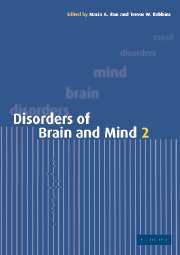Book contents
- Frontmatter
- Contents
- List of contributors
- Preface
- Part I Genes and behaviour
- Part II Brain development
- Part III New ways of imaging the brain
- Part VI Imaging the normal and abnormal mind
- Part V Consciousness and will
- Part IV Recent advances in dementia
- 12 The neurobiology of the tauopathies
- 13 Advances in early diagnosis and differentiation of the dementias
- Part VII Affective illness
- Part VIII Aggression
- Part IX Drug use and abuse
- Index
- Plate section
- References
13 - Advances in early diagnosis and differentiation of the dementias
from Part IV - Recent advances in dementia
Published online by Cambridge University Press: 19 January 2010
- Frontmatter
- Contents
- List of contributors
- Preface
- Part I Genes and behaviour
- Part II Brain development
- Part III New ways of imaging the brain
- Part VI Imaging the normal and abnormal mind
- Part V Consciousness and will
- Part IV Recent advances in dementia
- 12 The neurobiology of the tauopathies
- 13 Advances in early diagnosis and differentiation of the dementias
- Part VII Affective illness
- Part VIII Aggression
- Part IX Drug use and abuse
- Index
- Plate section
- References
Summary
Introduction
Over the past decades the concept of dementia has evolved from one of progressive global intellectual deterioration, to a syndrome of progressive impairment in memory and at least one other cognitive deficit (aphasia, apraxia, agnosia, or disturbance in executive function) in the absence of another explanatory central nervous system disorder, depression or delirium (DSM-IV). Furthermore, within this broad definition, the delineation of particular patterns of focal cognitive deficit associated with different dementia syndromes has greatly advanced over recent years. In epidemiological terms, dementia presents a significant problem; Alzheimer's disease alone affects 15 million people worldwide at present (Evans et al. 1989), and with the current demographic trend, this number will certainly increase.
With the advent of new and potentially disease-modifying therapies, attention has been focused on the need for reliable and early markers of dementia. In pursuit of this, a major expansion in dementia research has occurred, directed towards both identifying subjects in the preclinical phase of illness and differentiating between dementia syndromes of varying aetiologies. A number of approaches have been followed, encompassing the disciplines of neuropsychology, neuropsychiatry, structural and functional neuro-imaging and neurobiology (the search for biological markers of disease).
In this chapter we will discuss some of the advances that have occurred within the specialities of neuropsychology, neuropsychiatry and neuro-imaging. A comprehensive review of this rapidly expanding field would not be possible in this brief overview of the subject. We have, therefore, concentrated on a number of key topics related to early diagnosis and differential diagnosis.
- Type
- Chapter
- Information
- Disorders of Brain and Mind , pp. 262 - 288Publisher: Cambridge University PressPrint publication year: 2003



